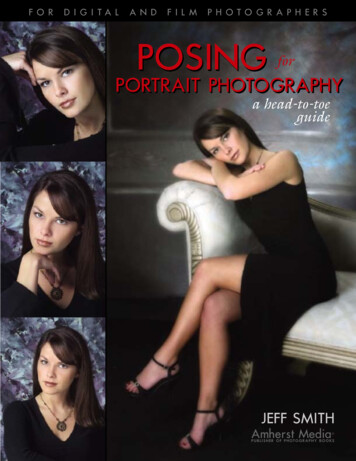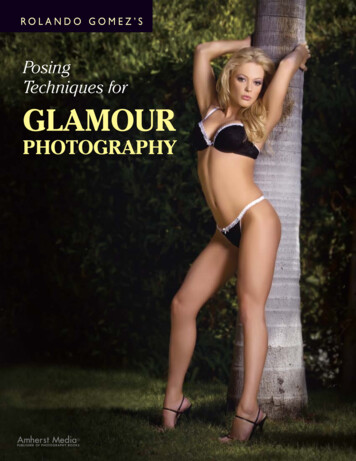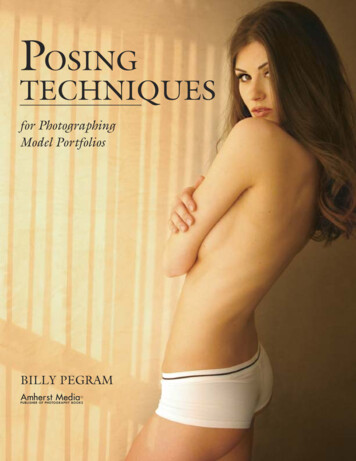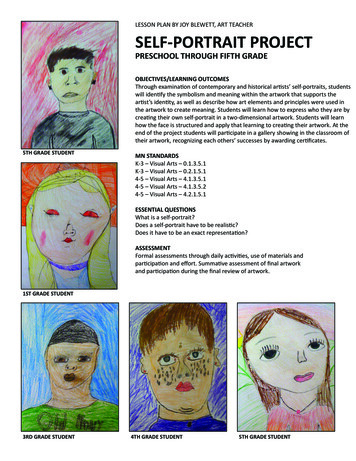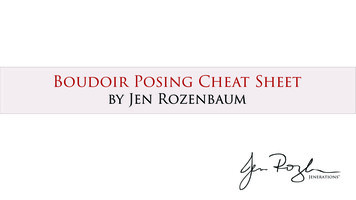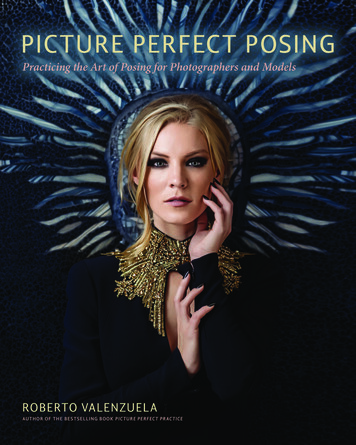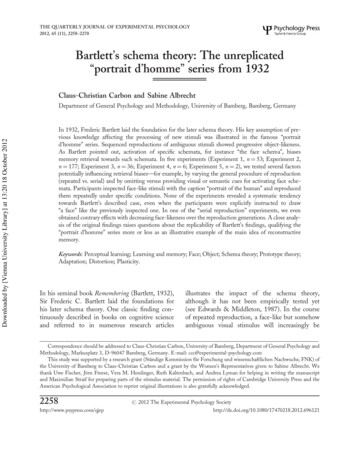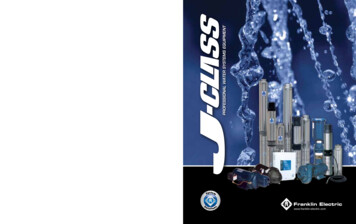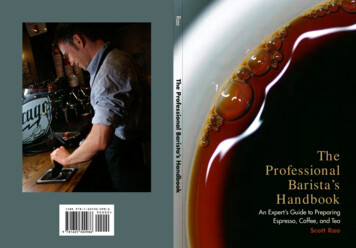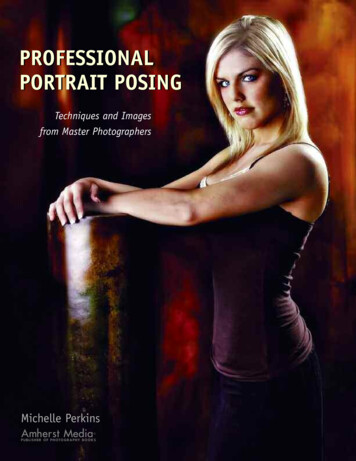
Transcription
PROFESSIONALPORTRAIT POSINGTechniques and Imagesfrom Master PhotographersMichelle PerkinsAmherst Media P U B L I S H E R O F P H OTO G R A P H Y B O O K S
ON THE FRONT COVER—Lafayette,LA, portrait photographer Tim Schooler picked up this clay pipe with a metallic finish froma Mexican import shop because he thought it would make a great prop. While Tim cautions his clients to avoid shortsleeved tops for their portraits, many still elect to wear them—and Tim must find some way to make them look good. Foreven thin subjects, bare upper arms can look thick when captured in a portrait. Here, Tim minimized the issue by creating a dramatic pose that lengthens the arms and lifts the torso, yielding a long, slim line that runs the length of the subject’s body. To learn more about Tim’s techniques, turn to page 71.ON THE BACK COVER—Tight three-quarter-length portraits like these are among Lake Mary, FL, portrait photographer TimKelly’s best sellers. “People like big heads,” he says. “When they’re looking at the images and making selections ona monitor, they ‘ooh’ and ‘ahh’ when a big, beautiful face comes up. This is my way of giving them more face—plusthe design element of hands. I just bring the hands closer to the face. Then, you have a headshot feel but with theelegance of a three-quarter length image.” To learn more about Tim’s techniques, turn to page 82.Copyright 2007 by Michelle Perkins.All rights reserved.Front cover image by Tim Schooler.Back cover image by Tim Kelly.Published by:Amherst Media, Inc.P.O. Box 586Buffalo, N.Y. 14226Fax: 716-874-4508www.AmherstMedia.comPublisher: Craig AlesseAssistant Editor: Barbara A. Lynch-JohntEditorial Assistance from: Carey A. Maines and Artie VanderpoolISBN-13: 978-1-58428-211-2Library of Congress Card Catalog Number: 2006937291Printed in Korea.10 9 8 7 6 5 4 3 2 1No part of this publication may be reproduced, stored, or transmitted in any form or by any means, electronic,mechanical, photocopied, recorded or otherwise, without prior written consent from the publisher.Notice of Disclaimer: The information contained in this book is based on the author’s experience and opinions.The author and publisher will not be held liable for the use or misuse of the information in this book.
TABLE OF CONTENTSIntroduction . . . . . . . . . . . . . . . . . . . . . . . . . . . . . . .47. Tim SchoolerSENIOR PORTRAIT SUCCESS . . . . . . . . . . . . . . . . .711. Jeff SmithCORRECTIVE POSING MAKES THE SALE . . . . . . . . . . .58. Tim KellyTIMELESS SIMPLICITY . . . . . . . . . . . . . . . . . . . . .822. Lori NordstromIN A FAMILY WAY . . . . . . . . . . . . . . . . . . . . . . . .169. Chris NelsonSENIOR STYLE . . . . . . . . . . . . . . . . . . . . . . . . . .943. Bill LemonCOMMUNICATION IS KEY . . . . . . . . . . . . . . . . . . .2910. Cherie Steinberg CoteAN ONGOING EXPERIMENT IN STYLE . . . . . . . . . .1074. Billy PegramFLAWLESS FASHION . . . . . . . . . . . . . . . . . . . . . . .39Conclusion . . . . . . . . . . . . . . . . . . . . . . . . . . . . . .117Appendix I: Individual Posing Basics . . . . . . . . . . . . .1185. Rolando GomezSUCCESS WITH THE GLAMOUR EDGE . . . . . . . . . . . .50Appendix II: Group Posing Basics . . . . . . . . . . . . . . .120About the Author . . . . . . . . . . . . . . . . . . . . . . . . . .121Index . . . . . . . . . . . . . . . . . . . . . . . . . . . . . . . . . .1226. Monte ZuckerCLASSIC STYLE . . . . . . . . . . . . . . . . . . . . . . . . . .61TABLE OF CONTENTS 3
INTRODUCTIONmherst Media’s Pro Photo Workshop series isdesigned to provide professional photographers(and aspiring professionals) with an inside look atthe working practices of leaders in the industry. In eachchapter, you’ll find a detailed look at the way one photographer has conquered the challenges of his or hermarket to build a successful business while still producing images that are creative and personally satisfying.In this particular volume, the challenge in questionis portrait posing. As you’ll see, each of the profiledphotographers approaches this in a unique way, basedon their personal tastes, the requirements and tastes oftheir clients, the realities of the location, and muchmore. But in the end, their goal is almost always theA4 PROFESSIONAL PORTRAIT POSINGTMsame: to create a portrait that says something about thesubject and satisfies—hopefully even thrills—theirclient.From commercial imaging, to fashion photography,to traditional portraiture, the looks that are in style areconstantly evolving. In this book, you’ll see how someof the most successful photographers around are usingthese changes to enhance their work and produce evermore appealing and marketable images.Thanks go out to the photographers who generously contributed their images, time, and knowledge tocreate this book. Without them, it wouldn’t have beenpossible.
1. JEFF SMITHCorrective Posing Makes the Saleeff Smith is an acclaimed portrait photographerwho specializes in senior portraits. Yet even whenworking with these subjects—people who areprobably the slimmest and most attractive they will everbe—he approaches each shoot with one question inmind: What would this person not want to see in his orher portrait?It may seem like a negative way to approach a session, but Jeff actually has his bottom line in mind. Afterall, regardless of the style, the props, or the composition, people ultimately buy portraits that make themlook good. The easiest way to accomplish that goal is toidentify potential problem areas and minimize or disguise them. And keep this in mind: whether the appearance issues in question are real or imagined from thephotographer’s point of view, it’s the client’s point ofview that matters. Even if you think her nose looks justfine, if a woman feels it’s too big, you’d better deemphasize it in her portrait if you want to make the sale.JIf there’s one thing that all portrait subjects have in common, it’sthe fact that they all want to look good in their pictures. As Jeffnotes, these are also the portraits that people ultimately buy, somaking subjects look their best is also critical to photographers.JEFF SMITHis an award-winning senior photographer from Fresno, CA. He owns and operates two studios in Central California and is well recognized as a speaker on lighting and senior photography. He is the author of many books, including CorrectiveLighting, Posing, and Retouching for Digital Photographers and Jeff Smith’s Lighting for Outdoor & Location Portrait Photography (bothfrom Amherst Media), and Senior Contracts (self-published). He can be reached via his web site: www.jeffsmithphoto.com.JEFF SMITH: CORRECTIVE POSING MAKES THE SALE 5
ately start to see what that person’s strengths and weaknesses are.” As you sum up the problems that need tobe addressed, you can start to make decisions aboutwhat poses you can use to hide this individual’s flaws,which of the client’s outfits would give you the most towork with (in terms of disguising problem areas), if theperson should do full-length images or not, etc.Once you have identified a flaw, you need to adaptthe subject’s pose to cover, disguise, or cast a shadowon the areas of the body and/or face that are problems.“Fortunately,” says Jeff, “many of the more relaxedposes that you will find already hide some of the mostannoying problems that your clients have.”ABOVE—One way to minimize the appearance of a double chin (top)is to have the client stretch their chin forward (bottom). FACINGPAGE—A pose like this can also be useful for concealing a problematic neck or chin area—plus, it has a glamorous look most womenwill love.IDENTIFYING PROBLEMSAccording to Jeff, there are two general types of problems that you will come across when working with yourclients: imagined problems and real problems.The imagined problems are usually very slight.“Most of the time,” says Jeff, “the person who has these‘problems’ is the only one who can see them.” Since noproblems are readily apparent, these are the problemsmost photographers fail to correct. “A typical imaginedproblem,” says Jeff, “is something like, ‘One of my eyesis smaller than the other,’ or ‘My smile is crooked.’”The real problems are the issues that almost everyone of us has. Says Jeff, “We are never as thin as wewould like, we think our noses are too large, our earsstick out too much, and our eyes are too big or toosmall, etc.” These problems are more easily identified asthings that need to be disguised in the portrait.Fortunately, a client’s problems can be evaluated ina matter of seconds. “When you sit someone down withthe main light turned on,” says Jeff, “you can immedi6 PROFESSIONAL PORTRAIT POSINGTHE HEAD AND FACEFor a natural look, the client’s head should be slightlytilted (not rigidly straight). This tends to happen naturally when you position a client and have them turntoward the main light. “The only time the head usuallyneeds to be repositioned,” says Jeff, “is when the clientis extremely nervous. When this happens, they tend todrop their head too far toward the higher shoulder.”Double Chin. A double chin (or the entire neckarea) is easily hidden by resting the chin on the hands,arms, or shoulders. “Be careful that the subject barelytouches his or her chin down on the supporting element,” warns Jeff. “Resting on it too heavily will alterthe jawline.”GET CREATIVE“Some photographers are so stuck in what they have alwaysdone that they bitterly resist any change,” says Jeff. “I oncetook a class on senior portraits. There was another photographer attending this class who was just starting out. Every timethe photographer conducting the class wasn’t talking, this photographer would ask me all kinds of questions. At lunch, we hadsome extra time, so, with permission, I went into the cameraroom and started showing my newfound friend some of the different poses we use with seniors. He loved it. Everything wasgoing fine until the photographer conducting the program camein. I was doing a yearbook pose that had the subject recliningback, to make the shoulders run diagonally through the frame.The photographer conducting the class remarked that this posewas more suited to boudoir than seniors. To reply, I simplyasked both photographers if the subject looked beautiful in thepose. They both responded affirmatively. I said that was all thatmattered.” The moral of the story? People just want to lookgreat—and not like mannequins.
Another way to make a double chin (orloose skin on the neck) a little easier onyour client’s ego is to stretch the skinunder the chin. To do this, turn the bodyaway from the light, then turn the faceback toward the light. This will stretchout the double chin so that it will not beas noticeable.When a head-and-shoulders pose isneeded (for a yearbook, business publication, etc.) it is sometimes impossible touse the hands or arms to hide this problem area. Posing the body to make theneck stretch can only do so much to hidea large double chin. In a case like this, Jeffrecommends doing what some photographers call the “turkey neck.” To do this,have the subject extend their chin directly toward the camera, which stretches outthe double chin. Then have them bringdown their face to the proper angle. Mostof the time, this eliminates the doublechin from view. It is especially helpfulwhen photographing a man who is wearing a shirt and tie. Men who have largedouble chins often also have tight collars,which push up the double chin and makeit even more noticeable.Ears. Corrective posing is also the bestway to combat the problem of ears thatstick out too far. Ladies who have a problem with their ears usually wear their hairover them. In this case, make sure thatthe subject’s hair isn’t tucked behind herears, as this will make them stand out.Larger ears can also stick out through thehair, making them appear really large.Without hair to conceal them, the bestway to reduce the appearance of the earsis to turn the face toward the main lightuntil the ear on the main-light side of theIn most portraits, your clients will want to see eyecontact—and they want their eyes to look as bigas possible.8 PROFESSIONAL PORTRAIT POSING
Paired with a flattering pose, a relaxed, natural expression can produce a portrait that virtually sells itself.face is obscured. Then, move the fill reflector fartherfrom the subject to increase the shadow on the visibleear, or move the main light more to the side of the subject to create a shadow over the ear.Noses. The nose is only seen in a portrait because ofthe shadows that are around it. “By turning the facemore toward the light or bringing the main light moretoward the camera, you can reduce the shadow on theside of the nose and reduce the apparent size of thenose,” says Jeff.Eyes. “Most people want their eyes to look as largeas possible,” says Jeff. “By turning the face toward themain light and bringing the subject’s gaze back to thecamera, the pupil shifts more toward the corner of theeye opening and gives the eye more impact as well as alarger appearance.”With a person with larger eyes that tend to bulge,the face needs to be directed more toward the camera.You must also make sure that no catchlight appears onthe whites of the eye, as this will draw a great deal ofattention to this area and make it much too bright.Expression. Proper expression depends on the ageof your clients. With babies and small children, parentslove laughing smiles. With children, moody, more serious expressions are salable. In dealing with teens andadults, the best expressions are more subtle.“While squinty expressions are cute on a baby, notmany adults really want to see themselves with no eyes,JEFF SMITH: CORRECTIVE POSING MAKES THE SALE 9
Turning the subject to an angle from the main light naturallyenhances the bustline.Posing the subject with their torso at an angle to the camera produces a slimmer view of the waist.huge chubby cheeks, and every tooth in their mouthvisible,” says Jeff. “Large smiles are unf
AmherstMedia PUBLISHER OF PHOTOGRAPHY BOOKS Techniques and Images from Master Photographers MichellePerkins PROFESSIONAL PORTRAITPOSINGFile Size: 2MBPage Count: 129
